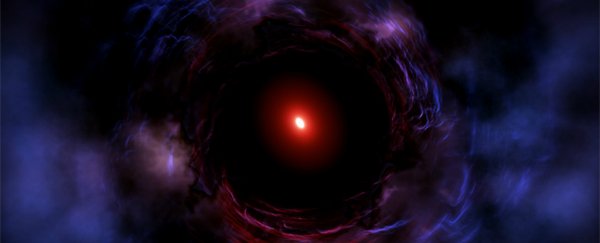For the first time, astronomers have spotted a massive, inactive galaxy from when the Universe was only around 1.7 billion years old, and no one can explain how it ended up there.
Our current understanding of galaxy formation states that all of the galaxies that existed back then should have been tiny and low-mass, and busy forming stars. Instead, this dead behemoth was already five times more massive than our Milky Way is now, all condensed into an area 12 times smaller, and had long finished its peak star formation.
If the discovery is verified by other teams, it means scientists will need to rethink the way galaxies form, and overhaul our assumptions about what happened in the first few billion years after the Big Bang.
It also suggests that there are plenty of surprises yet to be found at the beginning of our Universe.
"This discovery sets a new record for the earliest massive red galaxy," said lead researcher Karl Glazebrook from Swinburne University of Technology in Australia.
"It is an incredibly rare find that poses a new challenge to galaxy evolution models to accommodate the existence of such galaxies much earlier in the Universe."

While there are still a lot of unknowns about how and when galaxies start and stop forming stars, our best models assume that it happened a while after the origin of the Universe - meaning it would have been at least 3 billion years after the Big Bang before dead galaxies such as this 'red nugget' would have appeared.
In the time before that, research suggests that most galaxies would have been low-mass and busy making stars. For example, astrophysicists predict that 1.7 billion years after the Big Bang, our own Milky Way galaxy would have been a "messy little dwarf galaxy with just 1/50th of its mass today", as the video above explains.
But this new galaxy, known as ZF-COSMOS-20115, contradicts that model entirely.
The new study suggests this galaxy had formed all of its stars (three times more stars than in our Milky Way today) during a rapid star-burst event that occurred relatively soon after the Big Bang, and by 1.7 billion years into the Universe's history, it was already done.
That makes it what's known as a quiescent or 'red and dead' galaxy, which is common to see around the Universe today, but no one had expected one to exist back then.
"This huge galaxy formed like a firecracker in less than 100 million years, right at the start of cosmic history," said Glazebrook.
"It quickly made a monstrous object, then just as suddenly it quenched and turned itself off. As to how it did this we can only speculate. This fast life and death so early in the Universe is not predicted by our modern galaxy formation theories."
Researchers had previously found hints of these strange, early maturing galaxies, but this is the first time researchers have properly detected on.
To peer so far back in time, the researchers used the giant W M Keck telescopes in Hawai'i. They were looking for emissions at near-infrared wavelengths, to give them information on the presence of old stars and a lack of active star formation in old galaxies.
When they first spotted ZF-COSMOS-20115, they didn't think it could be real, Glazebrook told Gizmodo.
"We used the most powerful telescope in the world, but we still needed to stare at this galaxy for more than two nights to reveal its remarkable nature," said one of the researchers, Vy Tran from Texas A&M University.
What's needed now is follow-up observations using sub-millimetre wave telescopes - something that the James Webb Space Telescope, which is set to launch in 2018, will be able to assist with from outside the interference of Earth's atmosphere.
"Sub-millimetre waves are emitted by the hot dust which blocks other light and will tell us when these firecrackers exploded and how big a role they played in developing the primordial universe," explains one of the team, Corentin Schreiber from Leiden University in the Netherlands.
Until then, it's anyone's guess how this giant dead galaxy came about so early in the timeline of our Universe, and you can bet that mystery is going to be keeping astrophysicists up at night for the months to come.
The research has been published in Nature.
